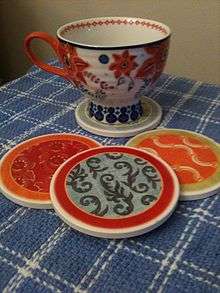Beverage coaster

A coaster, drink coaster, beverage coaster, or beermat is an item used to rest beverages upon. Coasters protect the surface of a table or any other surface where the user might place a beverage.
Public houses usually will have beermats spread out across their tables. They are used not just to protect the surface of the table, but, as they are usually made of paper, they can also be used to absorb condensation dripping along the glass or serve as an ad-hoc notepad. Beermats are often branded with trademarks or alcohol advertising. Beermats are not to be confused with bar mats, rectangular pieces of rubber or absorbent material used to protect the countertop and soak up spilled drinks in a bar or pub.
History
Back in 1880, the first beermats made of cardboard were introduced by the German printing company, Friedrich Horn.[1] In 1892, Robert Sputh of Dresden manufactured the first beermat made of wood pulp.[2] Watney brewery introduced them to the United Kingdom in 1920 to advertise their pale ale.[2] The packaging company Quarmby Promotions, established in 1872, began manufacturing beermats in Milnsbridge in 1931. After Quarmby Promotions was taken over by the Katz Group, it moved production to Brighouse and in 2006 to Morley, West Yorkshire, before closing its production in 2009.[3]
Saucers are also long used in western culture for much the same purpose. When drinking tea, it is customary to use a cup and saucer set. By the mid-twentieth century, beverage coasters made in many materials and styles were being manufactured for domestic use. Today, they are common as an everyday houseware piece and as well as used in restaurants.
Manufacture

Coasters are often made from high grammage paperboard, but may also be made from several layers of tissue paper. Important parameters for beer mats are water absorbency, wet rub and printability.[4][5][6]
More recently, glass coasters with empty frames have been produced. The consumer can then personalize each one with a different picture or design.
Coaster Factory and Canada Coaster, based in North America, and The Katz Group, based in Weisenbach, Germany, produce approximately 75% of the estimated 5.5 billion beermats in the world,[2] including about two-thirds of the European market and 97% of the US market.[1] In addition to the factory in Weisenbach, Katz has another two conversion factories in the U.S., one in Sanborn, New York and the other in Johnson City, Tennessee.[2]
Coaster imprints
Beermats are usually adorned with a customized image—usually mentioning or advertising a brand of beer, although they can also be used to promote a drinking establishment, sports franchise, businesses or special events. Recently, they have also been used to advertise political messages and parties, such as the UKIP beermats during the 2004 European Elections.
Tegestology
Some coasters are collectible items. Tegestology is a term coined from Latin (teges, -etis covering, mat) defined as the practice of collecting beermats or coasters, with practitioners known as tegestologists.[6] A 1960 British Pathe News short shows comedy duo Morecambe and Wise as tegestologists.[7]
References
- 1 2 "Tough Times for the Humble Beer Mat". Spiegel Online. SPIEGELnet GmbH. 2009-04-24. Retrieved 2009-05-26.
- 1 2 3 4 Atkinson, Simon (2009-05-26). "Last orders for beer mat maker?". BBC News. BBC. Retrieved 2009-05-26.
- ↑ Atkinson, Neil (2008-12-01). "Jobs lost as historic beer mat firm moves to Germany". Huddersfield Examiner. Trinity Mirror North West & North Wales Limited. Retrieved 2009-05-26.
- ↑ "Roller Coaster Manufacturers".
- ↑ "Custom Drink Coasters". Archived from the original on November 5, 2016. Retrieved November 5, 2016.
- 1 2 Oxford English Dictionary (first citation 1960).
- ↑ Morecambe And Wise (1960). YouTube. 13 April 2014.
External links
| Look up beverage coaster in Wiktionary, the free dictionary. |
![]() Media related to Beermats at Wikimedia Commons
Media related to Beermats at Wikimedia Commons
